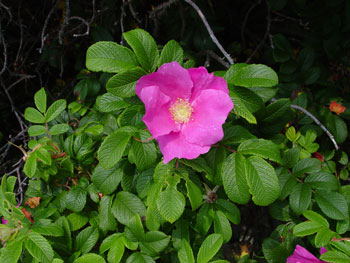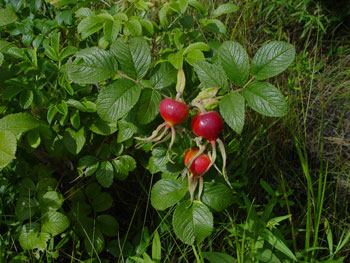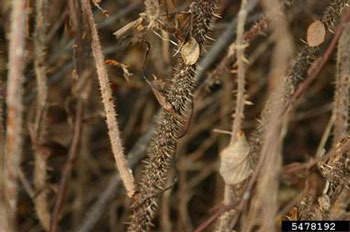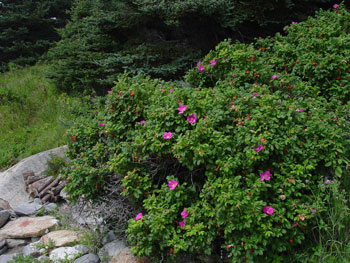DACF Home → Bureaus & Programs → Maine Natural Areas Program → Communities, Plants, and Animals → Invasive Plants → Rugosa Rose
 Rugosa rose flower
Rugosa rose flower
Rugosa Rose
(Beach rose)
Rosa rugosa
2019 Status in Maine: Widespread. Very Invasive.
Description: Perennial, deciduous shrub, up to 7' tall. Leaves: : Pinnately compound, 5-9 oval leaflets, each ~1-2" long, with teeth. Leaves are heavily veined, appearing wrinkled, hence the name "rugose" (wrinkled). Flowers: Showy, 5-petaled, usually dark pink (occasionally white or light pink), ~2" wide, in leaf axils, starts blooming in June in Maine. Fruit: ~1" round, red, rose "hips." Stems: With dense, straight prickles.
Reproduction: Spreads vegetatively, creating dense thickets by spreading rhizomes. Rhizomes can also float and establish new locations. Also spreads by seed; fruits and seeds float and can be transported by water. Occasional seed transport by birds or small mammals eating fruit.
Native range: Japan, China, Korea. How arrived in U.S.: As an ornamental.
 Rugosa rose fruit/hips
Rugosa rose fruit/hips
Habitat: Planted in a variety of locations but only seems to successfully invade beach dunes and coastal habitats, perhaps due to dispersal of seeds by tides. Tolerant of salt spray and poor (but well-drained) soils.
Similar native species: No native rose has such large, showy flowers, densely prickly stems, and rugose (wrinkled) leaves.
Similar non-native species: Many ornamental roses have showy flowers but do not escape to minimally managed areas. Rugosa rose is distinctive with densely prickly stems and rugose leaves.
Fact Sheets and Identification Links
- Invasive Plant Atlas page for Rosa rugosa
- Go Botany page for Rosa rugosa
Control Methods
Small plants and seedlings may be pulled up by the roots when soil is moist (wear gloves!); larger plants can be cut, but re-sprouting will occur.* Persistent cutting or mowing multiple times during the growing season over several years may kill the plant, but diligence is required. Mowing can prevent seedlings from establishing. Herbicides† are effective as foliar applications (glyphosate solution) or cut-stump applications (glyphosate or triclopyr solution applied immediately after cutting except in early spring), though the latter method is tedious due to numerous canes. Special rules apply to herbicide use in or near wetlands and water bodies - consult the Maine Board of Pesticides Control.
* Correctly dispose of all plant parts↵ † Follow all label directions when using herbicides↵ Rugosa rose stems. Leslie J. Mehrhoff, University of Connecticut, Bugwood.org
Rugosa rose stems. Leslie J. Mehrhoff, University of Connecticut, Bugwood.org
Control Technique Video Demonstrations
- No appropriate control videos found
Please email invasives.mnap@maine.gov if you have questions about invasive species in Maine
 Rugosa rose growing near a beach
Rugosa rose growing near a beach